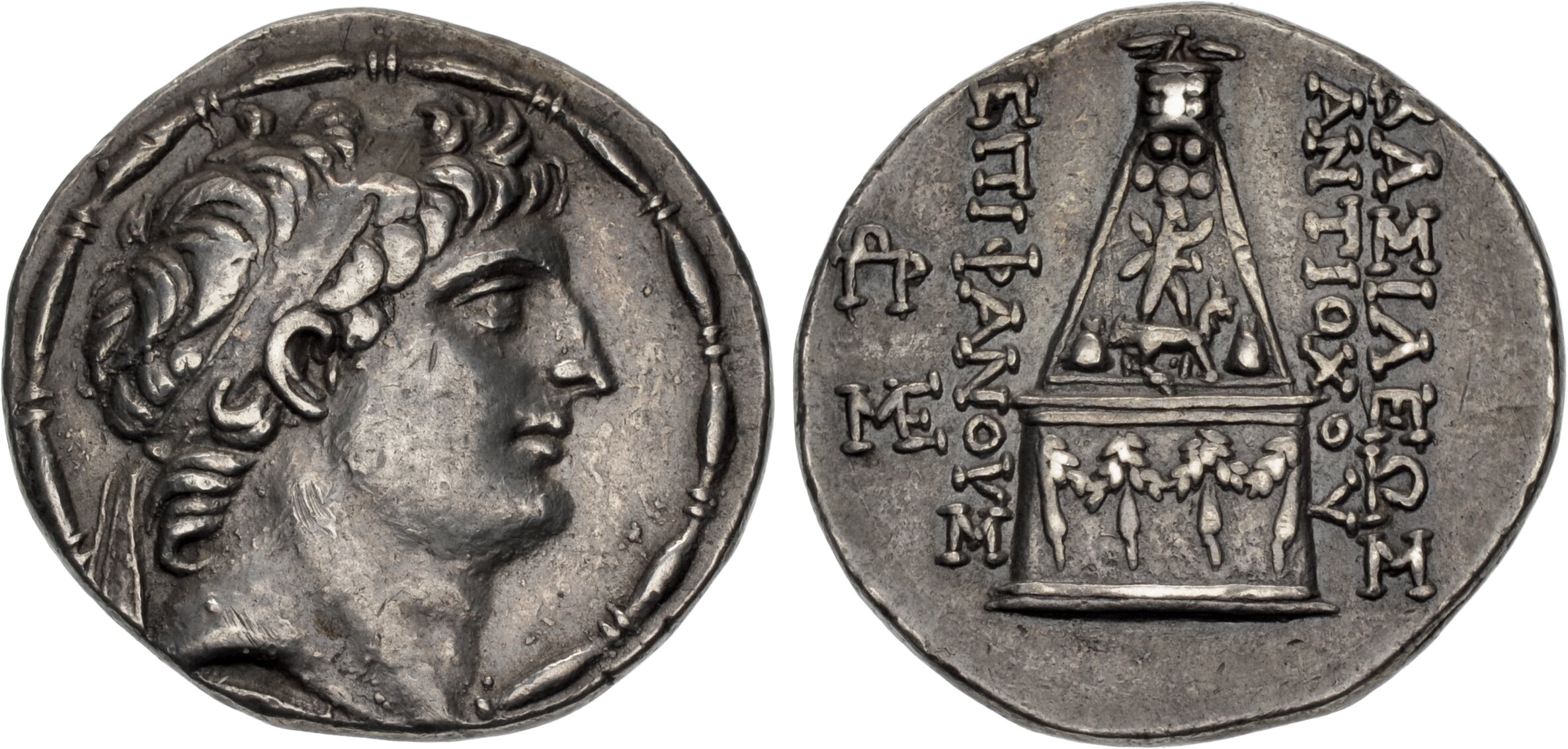Tarsus (Antiochus VIII), silver, tetradrachms (112-110 BCE)
From SILVER
112 BCE - 110 BCE Silver 987 kg
Description
| ObverseInscription or printing placed on the obverse.: | Diademed head right within fillet border |
| ReverseInscription or printing placed on the reverse.: | BAΣIΛEΩΣ ANTIOXOY EΠIΦANOYΣ (Greek).Sandan standing right on back of horned and winged lion standing right upon garlanded altar with baldachin, two monograms to outer left |
Mint and issuing power
| MintIdentifies the place of manufacture or issue of a numismatic object.: | Tarsus | Ancient regionAncient region.: | Cilicia | Modern countryModern country: Turkey | AuthorityIdentifies the issuing power. The authority can be "pretended" when the name or the portrait of X is on the coin but he/she was not the issuing power. It can also be "uncertain" when there is no mention of X on the coin but he/she was the issuing power according to the historical sources: | Antiochus VIII Grypus (Seleucid king, 121/0-97/6 BC), Seleucid Dynasty (312-63 BC) |
Chronology
| FromIdentifies the initial date in a range assigned in a numismatic context. | 112 BCE | toIdentifies the final date in a range assigned in a numismatic context.. | 110 BCE | PeriodTime period of the numismatic object.: Hellenistic 323-30 BC |
Physical description
| MetalThe physical material (usually metal) from which an object is made.: | Silver |
Median weightMedian of the weights of numismatic objects (in grams). in grams | 16.40 | DenominationTerm indicating the value of a numismatic object. Examples: tetradrachm, chalkous, denarius.: | tetradrachm |
StandardStandard.: | Attic |
Image

S2111 Tarsus Antiochus VIII 112-110.jpg [1]
References
| Die study referencePublication of the study: | Houghton 19931Houghton 1993, p. 94 | ||
| Coin series referenceReference to coin series study: | SC II2SC II, n° 2288, HGC 93HGC 9, n° 1198 | ||
Obverse dies distribution
no distribution is available
Reverse dies distribution
no distribution is available
Quantification
| Number of obversesNumber of obverse dies. ᵖ (o) | 3 | Number of singletons (o1)The number of singleton coins. ᵖ | |
| Number of reverse diesNumber of reverse dies. (r) | Number of coinsNumber of coins. (n) | 35 | |
| Coins per obverse dieNumber of coins per obverse die. (n/o) | 11.67 | Coins per reverse dieNumber of coins per reverse die. (n/r) | |
| Reverse per obverse ratioRatio of obverse dies divided by reverse dies. (r/o) | Percentage of singletons (o1)number of coins (n) divided by the number of singletons (o1) ᵖ | % | |
| Original number of dies (O) (Carter 1983 formula)The estimation of the number of coins according to Carter 1983 ᵖ | 3.01 | Coins struck if 20,000 as average productivity per dieCoins made if the average productivity for obverses (according to Carter) is 20,000. ᵖ | 60,200 |
| Original number of dies (O) (Esty 2011 formula)The estimation of the number of coins according to the singleton formula in Esty 2011 ᵖ (O) | 3.28 | Survival rate if 20,000 as average productivity per dieSurvival rate if average productivity is 20,000. ᵖ | 0.00058 |
| Coverage (o = % of O) (Esty 1984 formula)Esty 1984 - coverage (% of O) ᵖ (o = % of O) | % | Die productivity if survival rate 1/2,000Average productivity if survival rate is 1/2,000. ᵖ | 23,255.81 |
| Weight of silver (in kg) if 20,000 coins per die (O = Carter formula)Carter 1983 * Median weight * 20000 (*10 if gold or electrum) ᵖ | 987 kg <br /> 987 kg | Die productivity if survival rate 1/5,000Average productivity if survival rate is 1/5,000. ᵖ | 58,139.53 |
Remarks